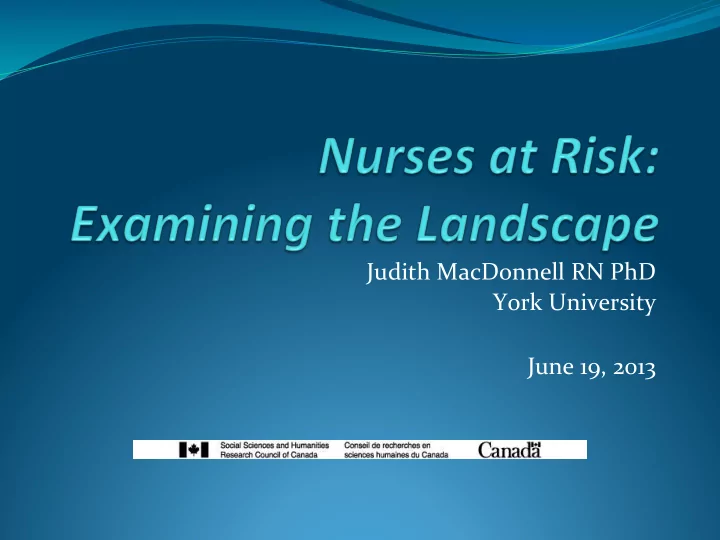

Judith ¡MacDonnell ¡RN ¡PhD ¡ York ¡University ¡ ¡ ¡ June ¡19, ¡2013 ¡ ¡ ¡ ¡
Acknowledgements ¡ Research ¡team: ¡ Pat ¡Armstrong ¡(PI), ¡Hugh ¡Armstrong, ¡Jacqueline ¡ Choiniere, ¡Tamara ¡Daly, ¡Walter ¡Giesbrecht, ¡Meredith ¡Lilly, ¡Judith ¡ MacDonnell, ¡Paul ¡Tulloch ¡ ¡ We ¡express ¡our ¡appreciation ¡to ¡the ¡participants ¡and ¡to ¡the ¡ Social ¡Sciences ¡and ¡Humanities ¡Research ¡Council ¡for ¡funding ¡ the ¡project. ¡ ¡ ¡ This ¡paper ¡is ¡based ¡on ¡findings ¡published ¡in: ¡ ¡ ¡ ¡Choiniere, ¡J.A., ¡MacDonnell, ¡J., ¡& ¡Shamonda, ¡H. ¡(2010). ¡Walking ¡ the ¡talk: ¡Insights ¡into ¡dynamics ¡of ¡race ¡and ¡gender ¡for ¡nurses. ¡ Policy, ¡Politics ¡and ¡Nursing ¡Practice , ¡11(4), ¡317-‑325. ¡ ¡
Purpose ¡of ¡“Nurses ¡at ¡Risk” ¡Study: ¡ Examine ¡impacts ¡of ¡gender, ¡racialization, ¡language, ¡social ¡ relations ¡on ¡nurses’ ¡work ¡& ¡health, ¡occupational ¡health ¡& ¡safety ¡ Create ¡policy ¡strategies ¡which ¡respond ¡to ¡particular ¡needs ¡of ¡ diverse ¡groups ¡ ¡ ¡ ¡ Began ¡with ¡a ¡Key ¡Informant ¡(KI) ¡focus: ¡ ¡ Reflect ¡voices ¡of ¡diverse ¡racialized ¡and ¡experienced ¡nurses ¡to ¡ offer ¡insights ¡into ¡the ¡current ¡landscape ¡of ¡nurses’ ¡work ¡ ¡ Identify ¡gaps, ¡ways ¡to ¡frame ¡questions, ¡priority ¡directions ¡for ¡ study ¡
Methodology ¡ Gender-‑based ¡/intersectional ¡lens ¡ (Health ¡Canada, ¡2000) ¡ Feminist ¡political ¡economy ¡ (Armstrong ¡et ¡al., ¡2000) ¡ ¡ Sample ¡ Purposeful ¡recruitment ¡of ¡7 ¡Key ¡Informants ¡ ¡ 5 ¡registered ¡nurses, ¡2 ¡non-‑nurses ¡ Female, ¡representation ¡of ¡racialized ¡groups ¡ Leadership/experience ¡in ¡all ¡domains ¡of ¡practice ¡ (clinical, ¡administration, ¡education, ¡research, ¡policy)/ Expertise ¡in ¡violence/equity ¡
Racializa@on ¡ Individuals ¡and ¡groups ¡who ¡are ¡racialized ¡“experience ¡ racism ¡because ¡of ¡their ¡skin ¡color, ¡ethnic ¡background, ¡ accent, ¡culture, ¡or ¡religion ¡… ¡ ¡ [Although ¡they ¡embody ¡many ¡differences], ¡what ¡they ¡have ¡ in ¡common ¡is ¡they ¡are ¡racialized—they ¡are ¡subjected ¡to ¡ racism ¡and ¡made ¡to ¡feel ¡different ¡because ¡of ¡their ¡racial/ ethnic/background” ¡ (Canadian ¡Research ¡Institute ¡for ¡the ¡Advancement ¡of ¡Women, ¡2005, ¡p. ¡1). ¡ See ¡also ¡Baines ¡& ¡Sharma, ¡2004; ¡McGibbon ¡& ¡Etowa, ¡2009. ¡ ¡
PaAerns ¡of ¡Violence: ¡ ¡ Pa@ents ¡& ¡Nurses ¡ Incidences ¡of ¡physical ¡abuse ¡ ¡ ¡“I’ve ¡seen ¡situations ¡where ¡because ¡the ¡person ¡looks ¡different ¡that ¡there ¡has ¡ been ¡physical ¡assaults ¡with ¡that ¡person ¡and ¡that’s ¡where ¡the ¡abuse ¡came…” ¡ ¡ Openly ¡abusive ¡remarks ¡ ¡ ¡ ¡“So ¡I ¡was ¡working ¡in ¡a ¡facility ¡once ¡and ¡she ¡said ¡she ¡wanted ¡a ¡Canadian ¡ Christian ¡English ¡speaking ¡nurse. ¡ ¡I ¡says ¡‘Well ¡that ¡would ¡be ¡me.’…I’m ¡ Christian. ¡ ¡I’m ¡Canadian. ¡ ¡And ¡I ¡speak ¡English. ¡ ¡That’s ¡the ¡only ¡language ¡I ¡ speak.’ ¡ ¡She ¡said ¡‘No. ¡ ¡I ¡want ¡a ¡white ¡person...” ¡ ¡ Patient-‑centred ¡tensions ¡ ¡ “Patients ¡would ¡speak ¡in ¡disrespectful ¡terms ¡or ¡. ¡. ¡. ¡call ¡them ¡names ¡. ¡. ¡. ¡ [Nurses] ¡ ¡felt ¡they ¡had ¡no ¡recourse ¡. ¡. ¡. ¡part ¡of ¡the ¡job ¡and ¡the ¡patient ¡is ¡ always ¡right” ¡ ¡ ¡ ¡
Ins@tu@onalized ¡PaAerns/Impacts ¡ Systemic/institutionalized ¡patterns ¡of ¡violence/abuse ¡–Across ¡settings ¡ Described ¡as ¡“micro-‑aggressions” ¡ ¡ ¡ “… ¡I’ve ¡certainly ¡experienced ¡it ¡as ¡a ¡faculty ¡member…as ¡a ¡manager ¡and ¡I’ve ¡ talked ¡to ¡other ¡colleagues…all ¡those ¡things ¡we ¡hear ¡about ¡… ¡ institutional ¡racism ¡or ¡systemic ¡racism… ¡there’s ¡over-‑scrutiny, ¡there’s ¡ challenge. ¡You ¡have ¡to ¡defend ¡yourself ¡more…explain ¡yourself ¡more… ¡I ¡ can ¡certainly ¡speak ¡to ¡how ¡it ¡impacts ¡the ¡overall ¡career ¡satisfaction….It ¡ takes ¡a ¡toll ¡on ¡people’s ¡health… ¡sometimes ¡I ¡don’t ¡think ¡you ¡can ¡address ¡ them ¡and…the ¡only ¡option ¡is… ¡‘I’m ¡getting ¡out ¡of ¡this ¡environment. ” ¡ ¡ ¡ Communication ¡tensions ¡ ¡ ¡ ¡“ needing ¡to ¡know ¡you’ve ¡got ¡my ¡back. ” ¡ ¡ ¡“ it’s ¡just ¡their ¡culture… ” ¡ ¡ ¡
PaAerns ¡of ¡Violence: ¡Reform ¡Direc@ons ¡ Current ¡management ¡practices: ¡Health ¡care ¡reform ¡ Care ¡needs ¡increasingly ¡complex ¡while ¡administrator ¡focus ¡ has ¡shifted ¡from ¡clinical ¡leadership ¡to ¡budgetary ¡issues/ administration ¡ Nurses ¡feel ¡abandoned, ¡lack ¡resources ¡to ¡avoid, ¡defuse ¡or ¡ respond ¡to ¡incidents ¡of ¡violence ¡ ¡ “Extensive, ¡protracted ¡understaffing, ¡underfunding ¡… ¡the ¡ shift ¡from ¡nurses ¡being ¡the ¡front-‑line ¡managers ¡to ¡…non-‑ nurses ¡(in ¡management ¡positions)….led ¡to ¡more ¡confusion ¡ and ¡less ¡coherence.” ¡ ¡
Implica@ons ¡of ¡Current ¡PaAerns ¡of ¡ Violence/Abuse ¡ Dynamics ¡of ¡violence ¡and ¡support ¡for ¡nurses ¡are ¡influenced ¡by ¡ the ¡intersections ¡of ¡race, ¡gender, ¡and ¡other ¡social ¡relations ¡in ¡ various ¡practice ¡settings. ¡ ¡ There ¡are ¡costs ¡to ¡individuals, ¡organizations, ¡systems ¡as ¡well ¡as ¡ patients, ¡providers ¡and ¡the ¡relations ¡of ¡care. ¡ ¡ “(R)acialized ¡nurses ¡experience ¡aggravated ¡forms ¡of ¡ harassment ¡. ¡. ¡. ¡[and] ¡report ¡experiencing ¡a ¡variety ¡of ¡mental ¡ health ¡symptoms, ¡physical ¡symptoms ¡. ¡. ¡. ¡withdrawal ¡from ¡the ¡ workplace. ¡[There ¡is ¡a] ¡connection ¡between ¡harassment ¡and ¡ illness.” ¡ ¡ “Racialized” ¡violence ¡ ¡ ¡
Supports ¡ 1) ¡Workplace ¡ ¡ (i) ¡ Programs ¡of ¡support ¡and ¡policies ¡intended ¡to ¡prevent ¡or ¡ respond ¡to ¡situations ¡of ¡abuse ¡and ¡violence ¡and ¡thus ¡ promote ¡quality ¡practice ¡environments; ¡ ¡ ¡ (ii) ¡ Administrative/resource ¡personnel ¡support , ¡including ¡ support ¡from ¡managers, ¡administrators ¡and ¡other ¡resource ¡ personnel, ¡available ¡reporting ¡processes. ¡ ¡ ¡ 2) ¡Professional/union/regulatory ¡ ¡ 3) ¡ ¡Educational ¡ ¡
Examples ¡of ¡Gaps ¡in ¡Support ¡ ¡ Despite ¡antiviolence/antidiscrimination ¡policies ¡and ¡focus ¡ on ¡mandatory ¡reporting, ¡workplace ¡safety ¡supportive ¡ policies/processes ¡are ¡not ¡available ¡or ¡effective ¡for ¡all ¡ nurses ¡ ¡e.g., ¡verbal/psychological ¡abuse ¡not ¡captured ¡in ¡reporting ¡ ¡ ¡“ The ¡fear ¡is ¡there…’Do ¡I ¡report ¡it ¡or ¡do ¡I ¡silently ¡bear ¡it ¡ because ¡I ¡am ¡who ¡I ¡am?’…If ¡they ¡feel ¡that ¡they ¡would ¡be ¡put ¡ at ¡a ¡disadvantage…blacklisted ¡or ¡whatever ¡listed…they ¡will ¡ not ¡report ¡the ¡violence…So ¡many… ¡injuries ¡at ¡work…not ¡ reported ¡…employers ¡are ¡giving ¡incentives ¡…for ¡not ¡taking ¡it ¡ any…further.” ¡
Recommend
More recommend